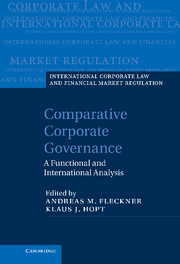Book contents
- Frontmatter
- Contents
- Contributors
- Preface
- Abbreviations
- Part I General report
- Part II National reports
- A Australia and Asia
- B Europe
- 6 Austria
- 7 Belgium
- 8 Denmark
- 9 Finland
- 10 France
- 11 Georgia
- 12 Germany
- 13 Hungary
- 14 Luxembourg
- 15 Netherlands
- 16 Norway
- 17 Poland
- 18 Portugal
- 19 Spain
- 20 Switzerland
- 21 United Kingdom
- C The Americas
- Part III Annex: Questionnaire
- Index
- References
14 - Luxembourg
Corporate governance of listed companies
from B - Europe
Published online by Cambridge University Press: 05 July 2013
- Frontmatter
- Contents
- Contributors
- Preface
- Abbreviations
- Part I General report
- Part II National reports
- A Australia and Asia
- B Europe
- 6 Austria
- 7 Belgium
- 8 Denmark
- 9 Finland
- 10 France
- 11 Georgia
- 12 Germany
- 13 Hungary
- 14 Luxembourg
- 15 Netherlands
- 16 Norway
- 17 Poland
- 18 Portugal
- 19 Spain
- 20 Switzerland
- 21 United Kingdom
- C The Americas
- Part III Annex: Questionnaire
- Index
- References
Summary
General information on corporate governance
Definition of corporate governance
There is no legal definition of “corporate governance” in Luxembourg. The only notable academic definition can be found in A. Steichen:
“corporate governance” or “gouvernement d'entreprise” . . . can be defined as “all the mechanisms which have for effect to organize the powers and to influence the decisions of managers, or to say it differently, which govern their conduct and define the area left to their discretion.” “Le corporate governance traite donc non seulement du mode d'organisation de la gestion sociale, mais également de son contrôle.”
The Ten Principles of Corporate Governance of the Luxembourg Stock Exchange (“TPCG”), which are mainly based on the (non-mandatory/flexible) “comply-or-explain” principle, formulate the following definition:
In a wide sense, “corporate governance” covers the organization of the control and management of a company. The term is also used in a narrower sense, to refer to the relationship between shareholders and management, and in particular the operation of the company's board.
- Type
- Chapter
- Information
- Comparative Corporate GovernanceA Functional and International Analysis, pp. 604 - 647Publisher: Cambridge University PressPrint publication year: 2013

